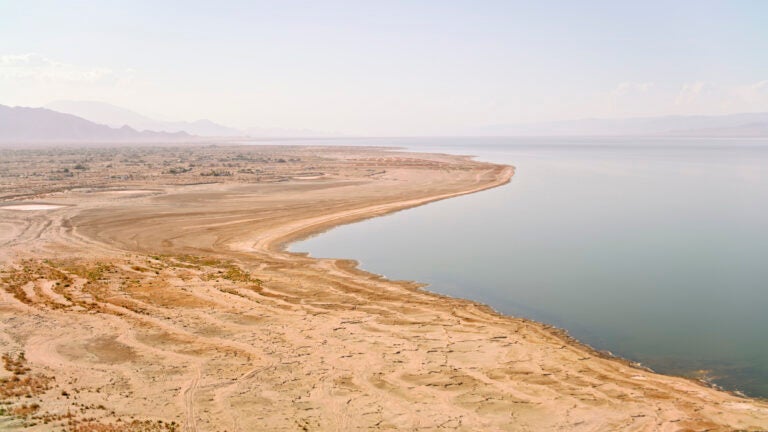
The Salton Sea holds enough lithium to power more than 375 million electric vehicle batteries. (Photo/iStock)
Lithium Valley: USC experts on California’s ‘white gold’ rush
The modern world runs on lithium, an essential material for batteries that power electric vehicles (EVs) and most electronics, including smartphones.
The Salton Sea in southern California’s Imperial Valley—now aptly dubbed “Lithium Valley”—has emerged as a global hotspot for this critical mineral and contains some of the world’s largest lithium deposits, according to a recent U.S. Department of Energy report.
But experts warn that the race to mine American lithium could come with significant environmental and public health impacts. USC experts are available for comment.
Contact: Nina Raffio, raffio@usc.edu or (213) 442-8464; USC Media Relations, uscnews@usc.edu or (213) 740-2215
California enters the global race to mine and refine lithium
In recent years, both the pandemic and geopolitical tensions have highlighted the risks of relying on foreign sources for critical materials like lithium, nickel and cobalt that power the batteries in our EVs and devices, experts say.
To achieve energy independence and ensure a sustainable supply of these materials, the U.S. needs to focus on domestic production of lithium-ion batteries and their components, said Greys Sošić, an expert in sustainability and global supply chains at the USC Marshall School of Business.
“To enable sustainable future production from local resources, the U.S. needs to reduce the amount of lithium used in batteries and/or seek alternative local sources of lithium,” she said, pointing to geothermal brine lithium recovery—a process that extracts battery-grade lithium from natural geothermal brines found in hot springs—as a viable alternative.
“Southern California’s Imperial Valley is becoming known as Lithium Valley, thanks to numerous geothermal energy projects at the Salton Sea Geothermal Resource Area and the fact that the geothermal brine generated by the process is rich in lithium.”
Contact: sosic@marshall.usc.edu
Clean energy’s dirty secret: Lithium mining comes with hidden public health hazards, experts say
“The childhood asthma rate for the communities around the sea is 22% compared to the national average of roughly 8%. Many children in this area are affected by respiratory symptoms, such as wheezing and allergies, and the local air quality is a likely contributor to the high rates we see,” said Shohreh Farzan, a USC researcher who has been collecting samples of air particles at elementary schools around the Salton Sea since 2017.
“The tradeoff with lithium is that while it can reduce our reliance on fossil fuels, there is much that remains to be understood about the environmental impacts of the extraction process and whether this energy transition could impact the health of the surrounding communities.”
Jill Johnston, an associate professor in the division of environmental health at USC, adds that “while efforts to move away from fossil fuels and promote zero-emissions technology is important for public health, it is critical to avoid creating new environmental hazards. The overly burdened families near the proposed lithium extraction site deserve to have clean air and water and protection of their health.”
Contact: sffarzan@usc.edu or jillj@usc.edu
North America’s cost-competitive advantage
“Although the quality of the lithium in North America brine varies, the extraction and refining can be as little as one-fourth of the cost of conventional lithium production that occurs in Chile, Argentina, and Australia,” said Shon Hiatt, an expert in innovation and sustainability in the global energy and agribusiness sectors and director of the recently launched Business of Energy Transition (BET) initiative at USC Marshall.
“A risk posed is the volatility of lithium prices, which have cratered 70% this year due to lagging demand for electric vehicles. If the price continues to fall, then startups in the lithium direct extraction (DLE) newer companies like Controlled Thermal Resources, EnergySource Minerals, and Standard Lithium may not have the capital to weather the lower commodity prices,” he said.
Contact: shiatt@marshall.usc.edu, or follow on X @ShonHiatt
Who will benefit from the economic boom?
“The future of the much-heralded ‘green economy’ remains uncertain in terms of delivering broad benefits for those who have been left behind and kept behind,” said Manuel Pastor, an expert in social and environmental justice, urban poverty and regional economies at the USC Dornsife College of Letters, Arts and Sciences.
“The Lithium Valley is a particularly compelling example: this is one of the poorest counties in California with a median household income roughly one-third of that in Silicon Valley, it has been ravaged by environmental conditions that have contributed to elevated asthma, and it has a population which is 85 percent Latino but with political representation falling far short of that standard. It is now poised for a potential economic boom – one promoted not just by companies but by environmentalists who believe that the method of lithium extraction being proposed there is the ‘greenest’ approach available. But the question is, who will benefit from the boom and who will face continued marginalization?”
Contact: mpastor@dornsife.usc.edu
###



